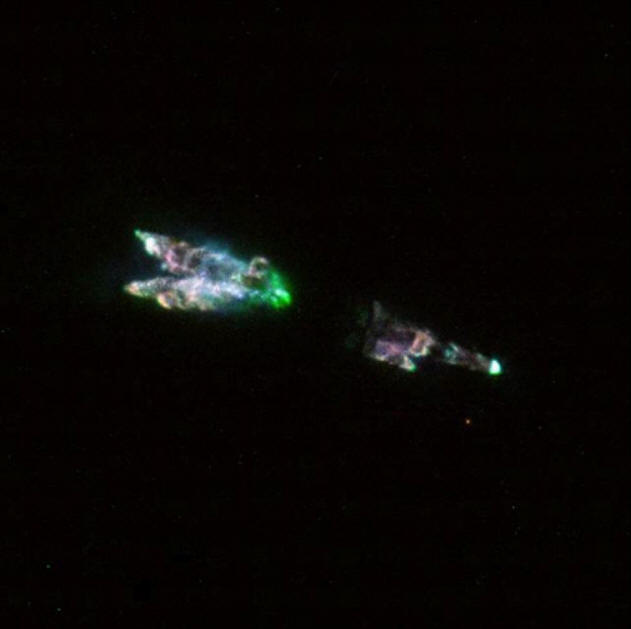|
|
A Twist of Plasma
Sep 22, 2009
Crisscross filaments are seen
expanding outward from a red giant
star. Are they hot gas or streams of
charged particles?
Complex jets of material are being
ejected from CRL 618 in the form of
rings, knots, and twisted streamers
of glowing gases. The overall shape
of the so-called "planetary nebula"
reveals two gigantic, bifurcated
jets emerging from the star,
indicating the beginnings of a
helical shape.
According to prevailing theories,
red giant stars expand outward
because they have "burned" most of
their primordial hydrogen and have
entered another stage of life where
they are consuming the helium that
was created in thermonuclear fusion
reactions. As hydrogen atoms fuse
into helium, the helium (being
heavier than hydrogen) sinks into
the stellar core, where it
accumulates over millions, if not
billions, of years.
Once the star has exhausted its
hydrogen fuel supply, it contracts
because radiative pressure is no
longer sufficient to overcome the
gravitational force that is always
trying to pull the star's outer
surface down into its core. As the
contraction continues, the internal
pressure rises and the star heats up
once more, until the temperature is
high enough for helium to fuse into
carbon. So that it can radiate the
energy produced by helium fusion,
the star expands its surface area
into the red giant phase.
After the stellar core material
reaches the stage where it can no
longer fuse into heavier elements,
the current model of stellar
evolution predicts that the star
will shed its outer surface layers
and reveal its hot, dense core,
gradually becoming a white dwarf.
During that progression, tremendous
volumes of glowing dust and gas
surround the star, often forming
braided streamers and helical
"tornadoes" in space. These "cosmic
slinkies" are known to Electric
Universe theorists as Birkeland
currents.
An electric discharge in plasma
creates a tube-like magnetic sheath
along its axis. If enough current
flows through the circuit, the
discharge will cause the sheath to
glow, sometimes creating a number of
other sheaths within it. The sheath
is called a “double layer.” Double
layers form when positive charges
build up in one region of a plasma
cloud and negative charges build up
nearby. A powerful electric field
appears between the two regions,
which accelerates charged particles.
The electric charges spiral in the
magnetic fields, emitting x-rays,
extreme ultraviolet, and sometimes
gamma rays.
In the above image of CRL 618, it is
the double layers that are glowing,
exposing the distinct boundaries
between sheaths. Since electric
currents flow along the sheaths, the
filaments (Birkeland currents)
attract one another over long
distances but repel each other when
they get too close. Rather than
coalescing, they twist around each
other, ultimately growing into long,
electric "transmission lines" in
space. Planetary nebulae, therefore,
should be thought of as gas
discharge tubes that are many
light-years long.
The consensus view of planetary
nebulae is based on explosive shock
waves through clouds of hot gas.
Since thermal and kinetic events are
chaotic, by definition, any light
from those events should exhibit
multiple frequencies. However, as in
CRL 618, over 90% of the light is
seen in a small range of
frequencies, mostly from ionized
oxygen.
As Hannes Alfvén observed, the
universe has become “...the
playground of theoreticians who have
never seen a plasma in a laboratory.
Many of them still believe in
formulae which we know from
laboratory experiments to be wrong.”
Alfvén reiterated that point
throughout his life: the underlying
assumptions of cosmologists today
“are developed with the most
sophisticated mathematical methods
and it is only the plasma itself
which does not ‘understand’ how
beautiful the theories are and
absolutely refuses to obey them."
Stephen Smith
|
|
|
|
|
|
SPECIAL NOTE - **New Volumes Available:
We are pleased to announce a new
e-book series
THE UNIVERSE ELECTRIC. Available now, the first volume
of this series, titled Big Bang, summarizes the failure of modern cosmology
and offers a new electrical perspective on the cosmos. At
over 200 pages, and
designed for broadest public appeal, it combines spectacular
full-color graphics with lean and readily understandable
text.
**Then second and third volumes in the series are now available,
respectively titled Sun and Comet, they offer
the reader easy to understand explanations of how and why these bodies
exist within an Electric Universe.
High school and college students--and teachers in
numerous fields--will love these books. So will a large
audience of general readers.
Visitors to the Thunderbolts.info site have often
wondered whether they could fully appreciate the Electric
Universe without further formal education. The answer is
given by these exquisitely designed books. Readers from
virtually all backgrounds and education levels will find them
easy to comprehend, from start to finish.
For the Thunderbolts Project, this series is a milestone.
Please see for yourself by checking out the new
Thunderbolts Project website, our leading edge in
reaching new markets globally.
Please visit our
Forum
|
|
|
|
|
|
|
|







